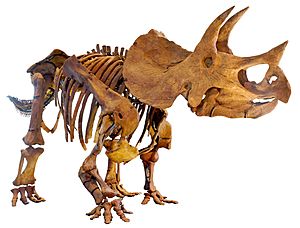Ceratopsids facts for kids
Quick facts for kids Ceratopsids |
|
|---|---|
 |
|
| A Triceratops prorsus skeleton, showing its large frill and horns. | |
 |
|
| A Centrosaurus "nasicornus" skeleton, displayed in a museum. | |
| Scientific classification |
|
| Kingdom: | Animalia |
| Phylum: | Chordata |
| Clade: | Dinosauria |
| Order: | †Ornithischia |
| Parvorder: | †Coronosauria |
| Superfamily: | †Ceratopsoidea |
| Family: | †Ceratopsidae Marsh, 1888 |
| Subgroups | |
|
|
| Synonyms | |
|
|
Ceratopsidae (say "Seh-rah-TOP-sih-day") is a family of dinosaurs that lived during the Late Cretaceous period. This group includes famous dinosaurs like Triceratops, Torosaurus, and Styracosaurus. All known ceratopsids walked on four legs and were herbivores, meaning they ate only plants.
These dinosaurs are special because of their unique features. They had strong, parrot-like beaks for biting off tough plants. Most importantly, they had amazing horns and large bony frills around their necks. These features probably helped them defend themselves from predators or show off to other dinosaurs. Most ceratopsids lived in Western North America, but some, like Sinoceratops, have been found in Asia. Possible fossils have also been found in Japan and Kazakhstan.
Contents
What are Ceratopsids?
Ceratopsids were a group of plant-eating dinosaurs. They lived from about 83 to 66 million years ago. This was during the last part of the Age of Dinosaurs. They were among the last non-bird dinosaurs to live on Earth.
Their Amazing Features
Ceratopsids are easy to spot because of their distinctive heads.
- Beaks: They had a sharp, hooked beak at the front of their mouths. This beak was perfect for snipping off tough leaves and branches.
- Horns: Many ceratopsids had horns on their faces. Triceratops, for example, had two long horns above its eyes and a shorter one on its nose. Other ceratopsids had different horn arrangements. Some had many smaller horns, while others had just one large horn.
- Frills: A large, bony frill extended from the back of their skulls over their necks. These frills varied greatly in size and shape. Some were solid, while others had large openings.
What were Horns and Frills For?
Scientists believe these impressive features had several uses.
- Defense: The horns were likely used to fight off large predators. Dinosaurs like Tyrannosaurus rex lived at the same time. A ceratopsid's horns could have been a powerful weapon.
- Display: The frills and horns might have been used for showing off. They could have helped ceratopsids attract mates. They might also have been used to tell different species apart.
- Species Recognition: Each type of ceratopsid had a unique horn and frill pattern. This helped them recognize others of their own kind.
- Temperature Control: Some scientists think the frills might have helped regulate body temperature. Blood vessels in the frill could have helped cool the dinosaur down.
Where Did They Live?
Most ceratopsids lived in what is now Western North America. This area was once covered by a large inland sea. This sea divided North America into two landmasses. Many different types of dinosaurs lived on these landmasses.
Life in the Late Cretaceous
The Late Cretaceous period was a time of great change.
- Climate: The climate was generally warm and humid. There were no polar ice caps.
- Plants: Flowering plants were becoming common. Ceratopsids would have eaten a variety of plants. These included ferns, cycads, and early flowering plants.
- Other Dinosaurs: Ceratopsids shared their world with many other dinosaurs. These included duck-billed dinosaurs (hadrosaurs) and large meat-eaters like tyrannosaurs.
Types of Ceratopsids
The Ceratopsidae family is divided into two main groups, called subfamilies.
- Centrosaurinae: These ceratopsids usually had a large horn over their nose. Their frills were often shorter and had spikes or knobs around the edge. Styracosaurus is a good example of a centrosaurine.
- Chasmosaurinae: These dinosaurs typically had long horns over their eyes. Their frills were often longer and more rectangular. Triceratops and Torosaurus belong to this group.
These two groups show how diverse ceratopsids were. Each group had its own unique look and features.
Fossil Discoveries
Many ceratopsid fossils have been found. These fossils help scientists learn about these amazing dinosaurs.
- First Discoveries: The first ceratopsid fossils were found in the late 1800s. Othniel Charles Marsh named the family Ceratopsidae in 1888.
- Important Sites: Many fossils come from places like Alberta, Canada, and Montana, USA. These areas have rich fossil beds from the Late Cretaceous.
- What Fossils Tell Us: By studying their bones, scientists can learn about their size, what they ate, and how they moved. Their unique skulls tell us a lot about their behavior.
Images for kids
See also
 In Spanish: Ceratópsidos para niños
In Spanish: Ceratópsidos para niños



